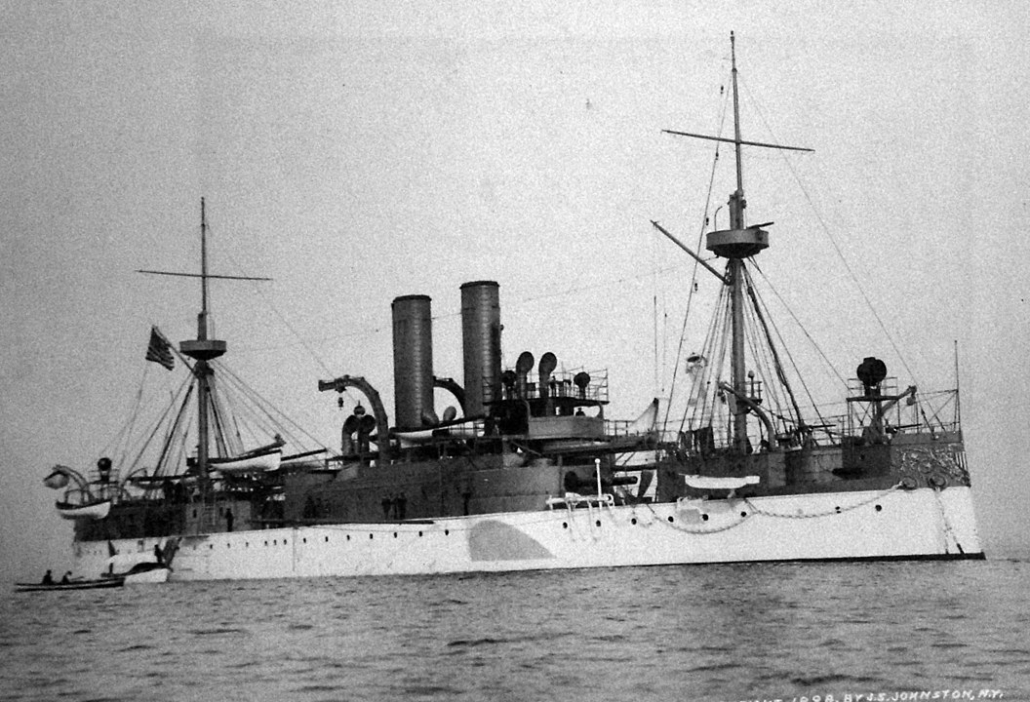Cannon on the corner

Courtesy photo This is photo of the USS Maine that was destroyed in 1898. One of the cannons from the ship is now on display in Alpena.
In 1862, during America’s Civil War, the U.S. Congress and Department of the Navy began naming combat ships after the nation’s states.
The USS Maine is named after America’s 23rd state. The over 324 foot “battle wagon” was a new generation of armored and heavily fortified ships.
In the late nineteenth century America was in the midst of a dynamic and growing industrial revolution. Coupled with this growth, America began to exhibit its might through land and sea military investments, growth, and visibility.
In 1886 the U.S. Congress allocated funds to design and build the Maine and subsequent battleships known as the “Great White Fleet”. It is named because of their white hull coloring.
Commissioned in 1895, the 6,789-ton Maine began a series of East coast port visits which included, Portland, Maine, Newport, Rhode Island, Sandy Hook, New Jersey, and Norfolk, Virginia.
During this period, Cuba was under Spanish control. Within Cuba there was internal revolution to break away from Spain.
America had geographic and strong and vital economic ties with Cuba vs. Spain. These were predominantly tobacco, sugar, and liquor imports to America.
In January 1898 the Maine sailed to Havana’s harbor from Key West, Florida. Their mission was to “show the flag” and protect U.S. interest during Cuba’s War of Independence from Spain.
It was Tuesday, February 15, 1898. At 11:40 p.m. a massive explosion rocked the Maine’s bow section. In this area there was a significant munition supply.
Of the ship’s 374 Naval officers and crew, 268 perished.
With immediate and numerous subsequent investigations, there has never been conclusive evidence of how this explosion occurred.
However, at this time, the theories and innuendos immediately pointed to Spanish sabotage. The explosion became a national, if not global story. The newspaper and magazine media along with other forums and American business and political leaders began using the phase; “Remember the Maine – to Hell with Spain”.
Thus, began America’s entry into the Spanish American War. Conflicts ranged from Cuba to Puerto Rico, Guam, and the Philippines – all controlled by Spain.
During this war is where then, U. S. Calvary member Theodore Roosevelt, became known for his charge up Cuba’s San Juan Hill.
The nearly six-month war ended with the Treaty of Paris. A total of 4,119 Americans perished with up to 56,600 Spanish being killed.
Historic news accounts stated, after the ship’s remains were raised, Alpena resident and Republican Congressman George A. Loud forwarded resolutions from the city’s Chamber of Commerce and Common Council to the Navy Department, requesting a loan of “a piece of naval ordinance of historical interest.”
In March 1912, the Navy granted the request, loaning Alpena a six-inch cannon from the Maine.
Alpena’s cannon arrived on May 19, 1912. The city performed a grand Independence Day celebration for the cannon’s unveiling. Additional news accounts stated the event attracted over 7,000 visitors.



